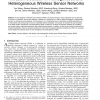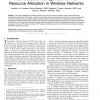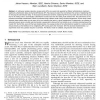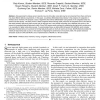TMC
2008
13 years 11 months ago
2008
Intrusion detection in Wireless Sensor Network (WSN) is of practical interest in many applications such as detecting an intruder in a battlefield. The intrusion detection is define...
TMC
2008
13 years 11 months ago
2008
This paper investigates the interaction between end-to-end flow control and medium access control (MAC)-layer scheduling on wireless links. We consider a wireless network with mult...
TMC
2008
13 years 11 months ago
2008
We consider the problem of finding "backbones" in multihop wireless networks. The backbone provides end-toend connectivity, allowing non-backbone nodes to save energy sin...
TMC
2008
13 years 11 months ago
2008
We consider a scenario in which a wireless sensor network is formed by randomly deploying n sensors to measure some spatial function over a field, with the objective of computing a...
TMC
2008
13 years 11 months ago
2008
In multiowner wireless networks, access points (APs) are owned and operated by different administrations, leading to significant authentication delays during handoff between APs. W...
TMC
2008
13 years 11 months ago
2008
Key predistribution has been claimed to be the only viable approach for establishing shared keys between neighboring sensors after deployment for a typical sensor network. However,...
TMC
2008
13 years 11 months ago
2008
Data generated in wireless sensor networks may not all be alike: some data may be more important than others and hence may have different delivery requirements. In this paper, we a...
TMC
2008
13 years 11 months ago
2008
Sensor deployment is a critical issue because it affects the cost and detection capability of a wireless sensor network. In this work, we consider two related deployment problems: ...
TMC
2008
13 years 11 months ago
2008
Mutual network synchronization is a distributed method in which geographically separated clocks align their times to one another without the need of reference or master clocks. Mut...
TMC
2008
13 years 11 months ago
2008
In multihop wireless networks, the variability of channels results in some paths providing better performance than other paths. While it is well known that some paths are better t...




